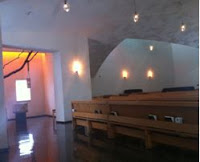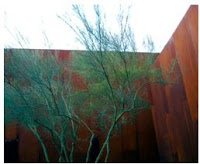CFM’s newly released TrendsWatch 2013 highlights the growing desire of people to disconnect from our perpetual tether to technology in general and the Internet in particular. This led to a Twitter exchange with Andrea Michelbach, a Masters candidate in museology at the University of Washington, who is working on research about the well-being of museum professionals. I asked Andrea to share her thoughts on the subject of unplugging, sparked by a course she took on “Information and Contemplation” through the Information School at UW.
“Mindfulness means paying attention in a particular way: on purpose, in the present moment, and nonjudgmentally.” –JON KABAT-ZINN
 |
|
Photo Credit: Andrea Michelbach
|
 |
|
Photo Credit: Andrea Michelbach
|
Rightnow, museums seem to be operating in the mode DavidLevy characterizes as “more–faster–better,” especially when it comes to technology. Perhapsit is time for museums to take a step back and become a cultural force for mindfulness, providing refugee in the melee rather than contributing to it.
Granted, museums may already be a force for mindfulness in today’s busy world. In Lois H. Silverman’s The Social Work of Museums (2010), she points out the ability of museums to “foster health by providing relief from physical tension and mental anxiety”—a claim akin to those made about Mindfulness–Based Stress Reduction. Silverman goes on to reference the attention restoration theory of psychologists Rachel and Stephen Kaplan, who suggest that museums can help solve “directed attention fatigue.” Museums can also provide objects for focus, as one might focus on the breath in some forms of meditation, and they can cultivate compassion, by linking the self to others.
In this 2007 article (also published in Museum News), Adam Gopnik saysthat today the mindful museum is one that is “aware of itself, conscious of its own functions and living in this moment.” To Gopnik, this means a museum that:
-
Focuses on objects (potential parallels with breath meditation)
-
Puts the “good stuff” out front (acknowledges the limits of our attention)
-
Does not explain the unexplainable (lives in the present, recognizing but not dwelling on difficult thoughts)
-
Encourages conversation (emphasizes personal experiences over a prescribed right or wrong)
From theon–the–ground perspective of a museum professional, mindfulness may find an even more practical place in museums through:
Public Programs. Given that museums can be places that cultivate health, introspection, and transcendence, as Silverman suggests, they may be a natural place for to practice mindfulness. This could take the form of a regular program, such as the weekly Mindfulness Meditations at the Frye Art Museum, or one that occurs less frequently, such asthe Slow Art Day coming up on April 27. What if mindfulness simply took the form of a handout: “mindful ways to engage with objects”?
Human Resources. By HR, I really mean all internal museum operations, including administration. What if meetings began with one minute of silence? What if job descriptions and work plans were more realistic about the time people actually need for full attention and reflection? What if museum professionals had time to think?
Education. Instead of focusing on meeting the curriculum requirements of public schools, informal museum education could focus on what is lacking in current formal educational practices, including mindfulness. What if instead of more–better–faster, we focused on less–present–slower? How could museum education teach kids to better stay inthe moment and attune their attention? I am reminded of the “TakeThis Fish and Look at It” story and of Visual Thinking Strategies, which asks, “What more can we find?”
Curation & Interpretation.What if object interpretation strategies focused more on the present and less on the past? What do the people of today think about this object’s meaning? This has been explored, for example, by Fred Wilson Mining the Museum for contemporary meaning of historic artifacts, or Barbara Bloom envisioning how Judaic objects might converse with each other today. How might this approach be expanded to encompass other voices, as well?
There are undoubtedly numerous other ways mindfulness could find a meaningful place in museums. And maybe your museum is already giving mindfulness a home. If so, please share what you’re doing. The best way to begin exploring these ideas may be through conversation. Are we, as a field, mindful? Do we want to be more mindful? How are we doing that—or how might we—in our particular jobs, at our particular institutions?
Personally, as someone about to enter the museum field, Ihope my first full-time museum job offers opportunities for mindfulness. Will I have time to think creatively and deeply? When I leave work, how “on” will I have to be through email and my phone? And once I am inthat first position, how will I be able to influence my immediate sphere to be more mindful? I believe this approach to mindfulness will prepare me to be the person I want tobe, living in the public world. I would love to hear from readers about their experiences withmindfulness in the workplace.










We've been talking about the off button at our museum for a while now:
http://peabodyslament.wordpress.com/2011/08/06/sci-fi-saturday-the-off-button/
T.H. Gray, Director-Curator
American Hysterical Society
How refreshing! I do wish that museums would turn in this direction and be the refuge from the 24/7 connected world that I think so many people need, (even if they don't think they do). I sincerely hope that you find an institution and position that foster your goals and I would love to join you there! Let's move from Emerging Museum Professionals to Mindful Museum Professionals.
Why can't this be a choice? I have never understood this either/or mentality with technology. Some people appreciate art more with the aid of an iPad guide, others want a purely meditative experience. Why can't both exist in the same place? Why should the museum choose for me the experience they would like me to have? Technology is about choice and accessibility. If I am a blind visitor and the museum has chosen to be a stripped-down, off-button zone, then what are my options?
This debate may get people into a lecture hall but the boring answer is this: Technology is a tool and it can be used to distract or engage. We should trust our visitors to make those choices for themselves.
I associate Mindfulness not so much with chilling out as with purposeful effort. Living in the now and responding to things that are current takes quite a bit of work, and it takes setting up systems that allow you to respond to the now instead of going through the slower museum channels. Takes some planning ahead.
It seems there is room for both technology and contemplative viewing in museums, but as the Museo-Mindfulness post notes, we've drifted far to the side of technology. A balance is needed.
In Los Angeles, the Hammer Museum has offered 30-minute mindfulness meditation sessions on a regular basis. They've also led the way in offering a 75-minute session for museum visitors that takes the mindfulness meditation practice into the galleries.
In an upcoming program, an alternative art space in El Segundo, California, is opening its gallery to a mindfulness art-viewing workshop. A mindfulness educator and an art historian will lead a 3-hour workshop at the new art laboratory ESMoA (El Segundo Museum of Art)on April 9. The workshop is experimental. One goal is to learn more about how the mindfulness meditation practice can be utilized by art museums to enhance the visitor experience.
Clare Kunny, Art Muse Los Angeles
Hi Gavin, absolutely to both sides of connection and disconnection being important! Recognizing that I may have a tendency myself to drift to one side of the spectrum (lock up your cell phone and then go enjoy the museum with your child), I try to keep the people who champion tech close. I just think more mindfulness — in the sense of slow, careful contemplation and in the purposeful present-focused effort Gretchen notes — could use some talking up and acting on.
Oops… Andrea above.
I appreciated this post. I think mindfulness is important. However, digital media for me does not fall at one end of a mindfulness spectrum with connectedness at the other end. Sometimes digital media can help me to connect with myself, those around me and the space and time I occupy. Other times it can serve to disconnect. Howard Rheingold's Net Smart: How to Thrive Online is the best resource I have found to talk about how to be mindfully present with our use of digital media.
Sorry…Found an error in the comment above and Blogger only allows for deletion, not editing of comments.
What I was trying to say was that if this contemplative mindfulness fits your mission, it needs a champion. Remember that person 5 or 6 years ago nagging you about Facebook and Twitter on the homepage? You need someone who cares just as passionately about contemplation to champion it. In doing so, it should not be to the extent that it becomes the only way to experience the museum.
Technology has a place. Quite mindfulness has a place. It just takes thoughtful integration.
I was so moved by this article I wrote about it on my blog. I have had completely transformative experiences by great curators and relative silence.
http://zenkatwrites.wordpress.com/2013/04/09/mindfulness-in-museums/
Hi Andrea,
What an interesting post. I did my master's research on mindfulness and contemplation in museums, and many museum educators are currently interested in a those same ideas you highlight, including VTS strategies and more. You should read a post on Art Museum Teaching by colleague Mike Murawski, who writes on the idea of engaging personal inquiry and contemplation: http://artmuseumteaching.com/2012/03/18/beyond-just-staring-personal-discovery-as-core-to-museum-learning/.
Good stuff!
Meagan Estep, The Phillips Collection
I finished grad school in arts admin last year, during school I strayed away from museum work as my primary interest and because of my job as a website administrator for an experimental performance space I am online and on all the time.
I am finding my ability to focus on tasks getting more difficult. I am interested in seeing where conversations about mindfulness in the work place will go. I think we all in the arts (and likely elsewhere) experience the feeling of never having enough time.
What have you found in your research about discussing mindfulness exercises with employers and leaders? How are they being utilized already? I am struggling to think this wouldn't get you laughed out of an office, especially in organizations much larger than mine.
Lyla Catellier
Asst Director, Elastic Arts
I'm really appreciating everyone's comments — thank you! I just came across this post on ExhibiTricks and think it, and the research by Reach Advisors that it highlights, have relevance to this discussion. The 2010 post talks about how visitors feel about technology in exhibits (and perhaps there has been a more recent study of this size?).
http://blog.orselli.net/2010/06/screened-out-preferences-for-technology.html
Museums not only could provide mindfulness through their exhibits but their employees could be consumers of it as well. Research has demonstrated that mindfulness improves focus, reduces stress and increases productivity, a win for any workplace.
Our newfound "do more with less" economy has affected businesses worldwide, including museums. As a result, many companies like Google, Target and General Mills have implemented successful mindfulness programs that have contributed to higher employee engagement (the extent to which one genuinely believes and contributes to the organization's mission and vision).
While mindful practice can include meditation, it's Westernized non-theistic metamorphosis includes exercises that can be incorporated into everyday personal and work routines.
Of course, the real opportunity would be to educate museum patrons on how to mindfully experience an exhibit as a means to a healthier wellbeing.
Erik Engberg
Mindful Solutions
Absolutely, Erik! I think the business advantage (increased focus and productivity) may be a great way to get leadership on board.